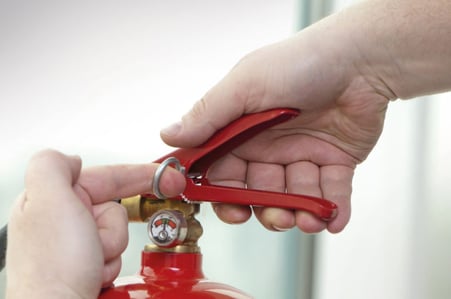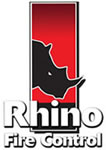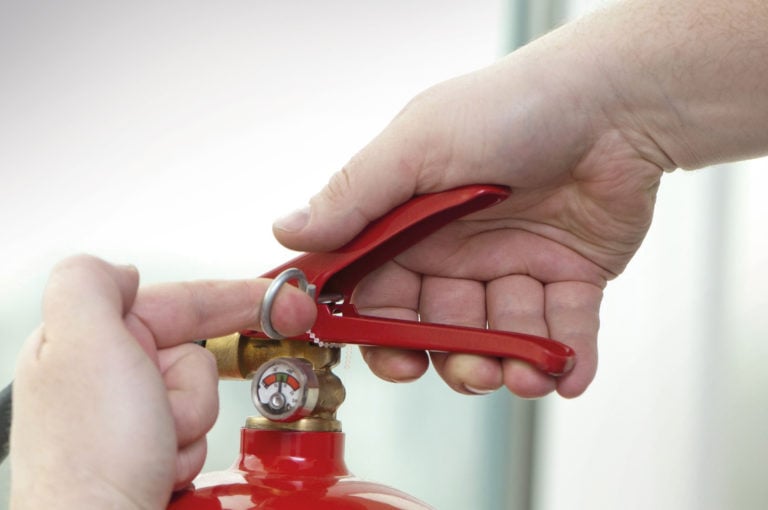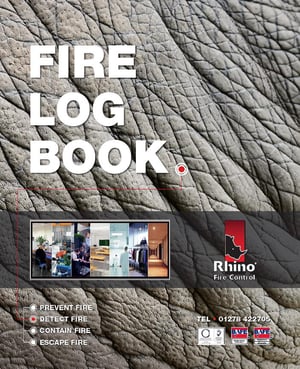All businesses should keep a fire safety log book to ensure that fire risk procedures, fire safety training and monitoring is adequately completed and up to date. Keeping a fire safety log book is necessary to ensure compliance under the Regulatory Reform (Fire Safety) Order 2005 (RRFSO 05). Here we are going to share with you some of the necessary steps you can take to ensure fire safety compliance.
SAFETY EQUIPMENT TESTING AND MAINTENANCE
A fire log book should hold all the details of the companies or individuals responsible for carrying out testing and maintenance of your safety equipment. You should keep a detailed record (or be provided one by your supplier) of all safety checks and their completion dates. This includes, but is not limited to, Fire Alarm testing, Fire Extinguisher testing, Emergency Lighting testing, Fire Suppression Systems testing and full maintenance. Weekly fire alarm testing should be carried out by the designated responsible person and a record kept of any issues or concerns.
REGARDING FIRE ALARM SYSTEMS
In order to satisfy the recommendations of BS 5839-1, the following need to be recorded in your fire log book:
- The names of the members of the premises management
- Dates of equipment installation
- Brief details of the maintenance arrangements
- Dates and times of all equipment tests
- Dates and times of all fires to which the system responds
- Dates and times of all false alarms
- Causes, circumstances surrounding, and category, of all false alarms (if known)
- The identity of any manual call point or automatic fire detector that triggers any of the above fire alarm signals (if known)
- Dates, times and types of all faults and defects
- Dates and types of all maintenance (e.g. service visit or non-routine attention)
- Dates and times of all fire drills
- Dates and times of all staff training
FIRE ALARM ACTIVATION AND FALSE ALARMS
 All incidents of a fire alarm activation should be recorded regardless of whether an actual fire has occurred. In order to ensure alerts are dealt with by staff in a timely fashion and taken seriously we also need to ensure that there are minimal false alarms in any given period. Regular unnecessary fire alarms can cause complacency in the workplace which exacerbates risk. If there is no attempt by the relevant member of the premises management to limit false alarms, the Fire Alarm System should no longer be considered as compliant with BS 5839-1.” Categories of False Alarm (clause 31 of BS 5839-1) To minimise risks we need to ensure 4 risk areas are avoided; A: The creation of fire like incidents such as heat from working activity, smoke from equipment or dust. These can be avoided by ensuring safety audits and risk assessments are completed and implemented correctly. B: System Fault Errors These errors should be avoided through proper fire monitoring system Design, Installation and Maintenance. C: Malicious False Alarms These risks can be limited through staff training and limiting access to workplaces to prevent outside tampering. D: False Alarms where someone makes an honest mistake These risks can be avoided by ensuring that adequate fire safety training is completed.
All incidents of a fire alarm activation should be recorded regardless of whether an actual fire has occurred. In order to ensure alerts are dealt with by staff in a timely fashion and taken seriously we also need to ensure that there are minimal false alarms in any given period. Regular unnecessary fire alarms can cause complacency in the workplace which exacerbates risk. If there is no attempt by the relevant member of the premises management to limit false alarms, the Fire Alarm System should no longer be considered as compliant with BS 5839-1.” Categories of False Alarm (clause 31 of BS 5839-1) To minimise risks we need to ensure 4 risk areas are avoided; A: The creation of fire like incidents such as heat from working activity, smoke from equipment or dust. These can be avoided by ensuring safety audits and risk assessments are completed and implemented correctly. B: System Fault Errors These errors should be avoided through proper fire monitoring system Design, Installation and Maintenance. C: Malicious False Alarms These risks can be limited through staff training and limiting access to workplaces to prevent outside tampering. D: False Alarms where someone makes an honest mistake These risks can be avoided by ensuring that adequate fire safety training is completed.
FALSE ALARM COMPLIANCY LEVELS
There are industry standardised acceptable incident levels which vary by sector and business size. The following framework provides an overview of acceptable incidents based on type of businesses and equipment. This will depend of many factors surrounding the circumstances, and the following are suggested rates: a) Office area, non-smoking, no cooking, well managed clean areas 1 false alarm per 100 detectors per year, or less b) Industrial site, shift working 1 false alarm per 75 detectors per year, or less c) Realistic rate of false alarms with modern technology 1 false alarm per 50 detectors per year, or less At sites with more than 40 detectors, an in depth investigation and action to reduce false alarms should be carried out if:
- The average annual rate exceeds more than 1 per 20 detectors
- 3 or more false alarms are initiated by the same call point, detector or location in a rolling 12 month period
At sites with less than 40 detectors, an in depth investigation should be carried out if:
- 3 or more false alarms occur in a rolling 12 month period
STAFF TRAINING
Staff training should be completed at the commencement of employment and yearly for all members of staff. It is also recommended that regular fire drills are carried out to ensure that the premises can be evacuated in a timely and organised fashion. Fire drills should take place at least twice a year and times and any issues should be recorded in your fire log book. Your log book should be kept up to date at all times and your maintenance contractors should supply you with all necessary paperwork and documentation. For any assistance in setting up fire risk management systems, safety equipment or staff training don’t hesitate to contact us directly. Keep a look out for future posts regarding testing and maintenance of Fire equipment.




